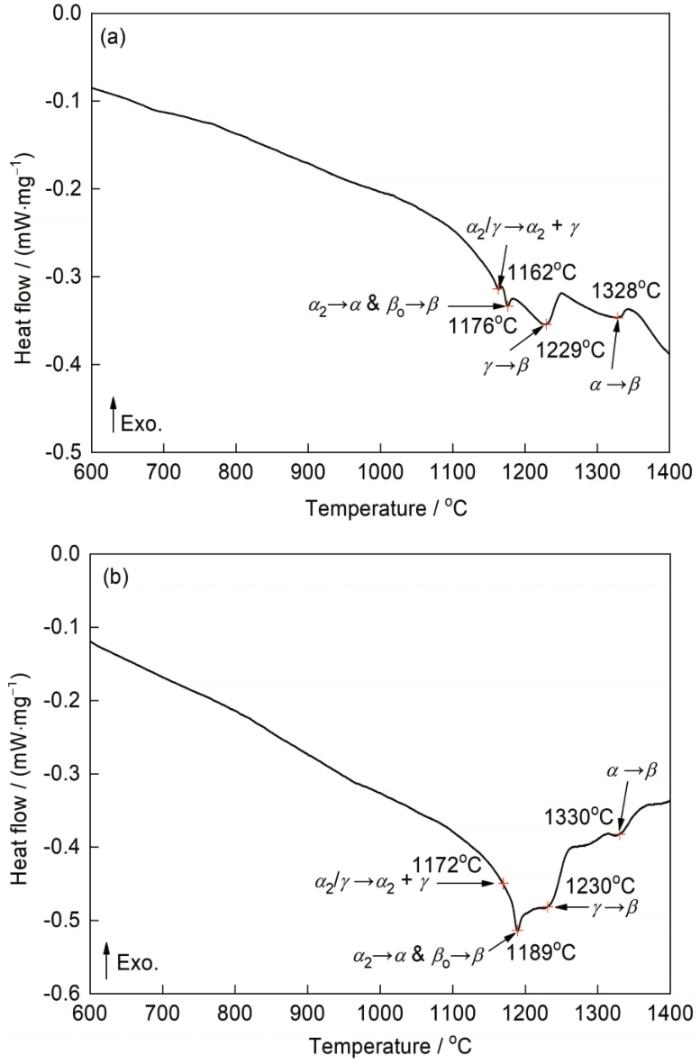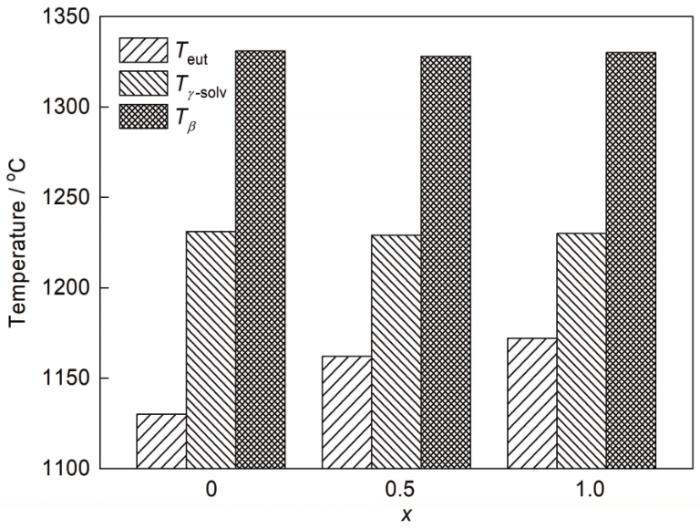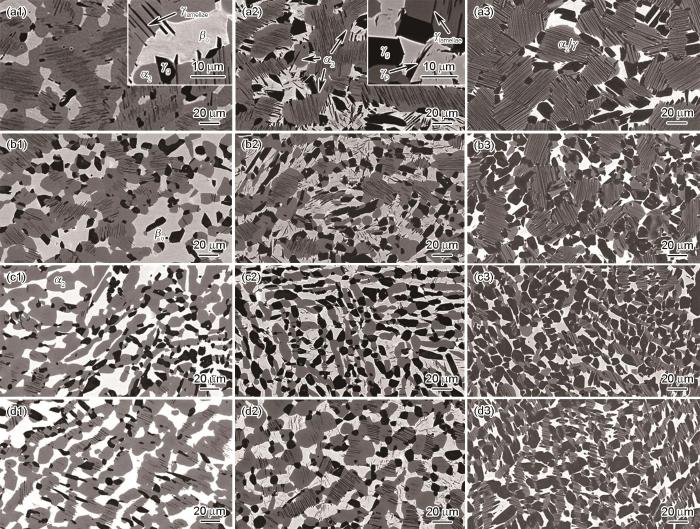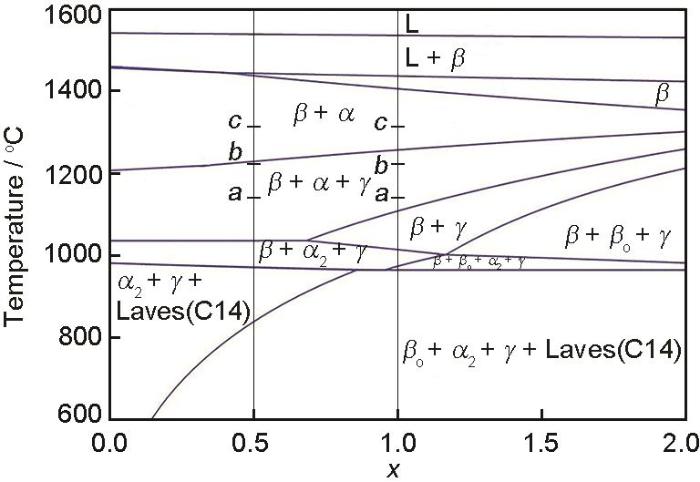γ-TiAl合金具有高的比强度、比模量,良好的抗髙温疲劳、抗蠕变和抗氧化腐蚀等性能,是航空航天、先进舰船、军用战机等发动机领域极具竞争力的尖端战略结构材料[1~4]。然而,作为金属间化合物,其高温塑性成形能力差,有效热加工窗口窄,致使相关部件制造极其困难,生产成本异常昂贵,这也成为制约γ-TiAl合金应用的关键瓶颈[5]。自2008年以来,国内外专家们通过降低合金中Al含量(40%~44%,原子分数,下同),并引入W、Mo、Mn、Cr等β相稳定元素研发了一类新的β凝固γ-TiAl合金[6~8]。该类合金通过控制较低Al含量使其凝固过程不经过包晶反应,同时添加适量β稳定元素使其在高温下获得大量韧性无序的β相,确保合金具有一定的热加工窗口,从而使γ-TiAl合金高温热加工变形成为可能。
在诸多β凝固γ-TiAl合金中,Tetsui等[9]提出的Ti-42Al-5Mn (原子分数,%,下同)合金,因具有较低的Al含量和足够量的β相稳定元素,可在常规条件下实现良好锻造变形,极大地降低了TiAl部件的成型成本,也打破了一直以来认为γ-TiAl合金难以实现常规条件热变形的传统观念。最近,通过对Ti-42Al-5Mn的研究发现,该合金虽突破了常规条件变形的瓶颈,但是却存在高温抗氧化性不足[10]和析出富锰Laves相[11]的2类新问题,此2类问题同样会严重制约其高温应用。在对Ti-42Al-5Mn合金高温抗氧化性和组织稳定性调控时发现,添加微量的β相稳定元素W不仅可大幅改善其高温抗氧化性[10],而且还可提高合金组织中βo (有序化的β相)相自身的热稳定性,减少Laves相的析出[12]。另一方面,作为强β相稳定元素的W,它的添加也将会对合金的相变行为和组织构成产生显著影响,掌握该影响规律对合金成分的优化设计显得尤为重要,但是有关W元素添加对Ti-42Al-5Mn合金相变行为的影响仍未见报道。
本工作以Ti-42Al-5Mn合金为研究对象,系统分析了0.5%~1.0%范围内W含量对合金特征相变点的影响,并研究了不同冷却方式(水冷、空冷、炉冷)条件下Ti-42Al-5Mn-xW (x = 0、0.5、0.8、1.0)合金的相变行为,结合Pandat计算软件综合讨论了W含量对Ti-42Al-5Mn合金相变影响及其机理。本工作旨在进一步掌握β相稳定元素对γ-TiAl合金相变行为的作用规律,以期为低成本含锰γ-TiAl合金的成分设计与优化提供指导。
1 实验方法
表1 Ti-42Al-5Mn-xW合金的化学成分 (atomic fraction / %)
Table 1
| x | Al | Mn | W | Ti |
|---|---|---|---|---|
| 0 | 41.62 | 4.87 | - | Bal. |
| 0.5 | 41.81 | 4.71 | 0.49 | Bal. |
| 0.8 | 41.54 | 4.90 | 0.78 | Bal. |
| 1.0 | 41.72 | 4.77 | 0.98 | Bal. |
采用SETARAM Evolution 18差示扫描量热仪(DSC)测量Ti-42Al-5Mn-xW合金的固态相变温度,具体相变测试方法及结果详见文献[14],本工作选取x = 0.5和1.0合金作为重点研究对象。DSC实验样品尺寸为直径3 mm、厚2 mm,总质量约为60 mg,表面经SiC砂纸研磨和抛光,以获得最佳导热性能,实验在高纯Ar气保护条件下进行,气体流量为20 mL/min,样品从室温以20℃/min的加热速率加热至1400℃,然后以20℃/min的冷却速率冷却至室温,记录其热流变化。为进一步验证上述测试结果,辨析不同相变温度对应的特征相变,选取x = 0.5合金为对象,开展辅助特征温度的水淬实验。水淬实验试样尺寸为直径8 mm、厚8 mm,表面机加后分别封管,管内用Ar气保护,避免实验过程发生氧化,详细实验方法详见文献[14]。
基于上述合金相变特征测试结果,对4种成分铸锭试样沿着冒口铸锭边缘切取系列直径8 mm、厚8 mm的试样,将系列试样分别在1200℃ (γ + α + β)三相区和1300℃ (α + β)两相区进行高温处理,保温时间为1 h,随后分别以水冷(WC)、空冷(AC)和炉冷(FC)方式冷却至室温。采用JXA-8530F电子探针(EPMA)在背散射电子(BSE) 模式条件下对上述系列处理试样的抛光组织进行观察。采用Image-Pro Plus 6软件,选取至少5张EPMA-BSE像统计显微组织中不同相或相区域对应的体积分数。基于Calphad方法,借助Pandat软件及其Pan_TiAl热力学数据库,针对Ti-42Al-5Mn-xW合金在x = 0~2范围及温度区间在600~1600℃的条件下进行相图计算。主要涉及液相(liquid,L)、hcp相(α2)、无序bcc相(β)与有序bcc相(bcc_B2/βo)、γ相及Laves相,考察单相区、双相区及多相区分布情况,与实验结果进行对比分析。
采用EPMA附带的能谱仪(EDS)分析长期时效样品中的γ、α2、βo、Laves相的化学成分,同时采用电子背散射衍射(EBSD)分析确定合金中βo、γ、α2、Laves相分布,试样尺寸为5 mm × 5 mm × 2.5 mm,经标准金相制样后用氩离子减薄至表面无明显变形。然后,将样品安装在70°预倾斜支架上并在配备有EBSD检测器的TES-CANMAIA 3 XMH场发射扫描电子显微镜(SEM)上进行检测,步长为30~100 nm,每次测量总共产生不低于2.4 × 105个数据点,以准确评估相组成和分布特征。
2 实验结果
2.1 合金相变特征
图1为x = 0.5和1.0合金对应的DSC加热曲线。根据热流变化可推断,2种合金在加热曲线上均出现4个极小值的吸热峰,表明,2种合金在该温度附近应存在相变反应。结合水淬实验结果推断,2种合金DSC曲线从低温至高温对应的4个吸热峰依次分别为α2/γ →α2 + γ (共析转变开始点),α2→α和βo→β有序到无序转变,γ→β转变(γ相溶解至β相的结束点),以及α→β转变(α相溶解至β相的结束点)。对比发现,2种合金对应的4个相变温度点变化并不大,且随着x由0.5%增加至1.0%,对应的相变温度点稍有增加。
图1
图1
Ti-42Al-5Mn-xW (x = 0.5和1.0)合金的DSC加热曲线
Fig.1
DSC curves of the Ti-42Al-5Mn-xW with x = 0.5 (a) and1.0 (b)
图2为Ti-42Al-5Mn-0.5W合金在上述吸热峰温度附近的水淬试样EPMA-BSE像。Yang和Lin[15]研究已指出,α和β相有序化转变对冷却速率并不敏感,换言之,即使在诸如水淬这样的高冷速条件下也难以完全抑制有序-无序化转变,因此本工作在标定不同条件下的组织类型时均以有序相进行标注。可以看出,当温度由1160℃提高至1170℃,能在原α2/γ片层组织区域检测到明显的条状γ相(γlamellae),表明该温度下片层组织中部分γlamellae已发生了回溶,因此1160~1170℃温度区间将对应合金的共析转变温度(Teut);当温度由1170℃提高至1220℃,片层组织中γlamellae相已基本全回溶于α2相,但在βo相中依然存在大量γ相晶粒(γg);当温度由1220℃提高至1230℃,βo相中的γg相则已完全回溶,合金开始进入α + β两相区,因此1220~1230℃温度区间将对应合金的γ相溶解温度(Tγ-solv);当温度由1320℃提高至1330℃,合金由α + β两相演变为β单相,该温度范围则对应β单相区温度(Tβ 或Tα )。据此,结合DSC的测试结果,得到x = 0.5和1.0的2种合金固态相变对应的特征温度,如图3所示。可以看出,随着x由0.5增加至1.0,合金Tβ 和Tγ-solv几乎未发生变化,而Teut小幅度增加。值得指出的是,由DSC测试结果看出,x = 0.5和1.0的2种合金分别在1176和1189℃存在吸热峰。但结合图2b和c,x = 0.5合金显微组织均由α2/γ片层、γlamellae、γg、βo构成,组织形态并未发生明显变化。根据Schwaighofer等[16]和Xu等[14]对Ti-42Al-5Mn合金相变的研究结果可知,该吸热峰应为相的有序化温度点。基于上述结果可知,Ti-42Al-5Mn-xW (x = 0.5、1.0)合金的固态相变路线为:β→β + α→β + α + γ→β(βo) + α(α2) + γ→βo + α2 + γ,也就是说,0.5%~1.0%含量的W添加并未明显改变Ti-42Al-5Mn-xW合金的相变路线[14]。
图2
图2
Ti-42Al-5Mn-0.5W合金不同温度保温1 h水淬后的BSE像
Fig.2
Back scattering electron (BSE) images of Ti-42Al-5Mn-0.5W alloy after annealing at 1160oC (a), 1170oC (b), 1180oC (c), 1210oC (d), 1220oC (e), 1230oC (f), 1320oC (g), and 1330oC (h) for 1 h,and then water cooling (WC) (γg—γ grain, γlamellae—γ lamellae)
图3
图3
W含量对Ti-42Al-5Mn-xW合金特征相变温度的影响
Fig.3
Effects of W concentration on the phase transformation temperature in Ti-42Al-5Mn-xW (The data of Ti-42Al-5Mn is quoted from Ref.[14]. Teut—eutectoid reaction temperature, Tγ-solv—γ phase solvus temperature, Tβ —β-phase single region temperature)
2.2 不同冷速下合金的相变行为
2.2.1 (γ + α + β)三相区冷却后相转变行为
图4为4种成分合金在1200℃ (γ + α + β)三相区处理后以不同方式冷却对应的显微组织,对应组织的定量统计结果列于表2。可以看出:(1) 水冷条件下,4种合金均包括γ、α2、βo相,其中γ相呈现出2种典型形貌,分别是位于α2区域的γlamellae和位于βo区域的块状γ相(γg)。对比来看,随着x由0.5增加至1.0,合金中γlamellae相含量稍有减少,γg相和βo相含量则呈现增加趋势。(2) 空冷条件下,4种合金组织中α2相未能完全转变为α2/γ片层组织,组织中仍存在较为明显的α2相,但βo相中析出一种区别于γlamellae和γg的另一种γ相,将其定义为γp相,这种相以相互交错的针状形貌存在于βo相中。该实验结果也表明,高温存在的β相自身并不稳定,在冷却过程会发生β→γ转变。对比来看,4种成分合金中βo相析出γp相特征并不相同,添加W后βo相中的γp相数量有所降低,且尺寸更小。这表明,添加W后合金冷却过程中β→γ转变得到一定程度的抑制。值得指出的是,空冷过程中,γg相含量稍有增加,而βo相含量并未出现明显变化。(3) 炉冷条件下,4种合金组织均由α2/γ片层和晶团周围的γg和βo相构成,并未检测到针状的γp相。随着W含量的增加,合金中α2/γ片层含量明显减少,当x = 0.8和1.0时,合金组织主要以γg和βo相为主。
图4
图4
Ti-42Al-5Mn-xW合金1200℃处理1 h后以不同方式冷却的BSE像
Fig.4
BSE images of Ti-42Al-5Mn-xW alloys with x = 0 (a1-a3), x = 0.5 (b1-b3), x = 0.8 (c1-c3), and x = 1.0 (d1-d3) after annealing at 1200oC for 1 h and then WC (a1-d1), air cooling (AC) (a2-d2), and furnace cooling (FC) (a3-d3) (Insets in Figs.4a1 and a2 show the high magnified images. γp—γ platelet)
表2 Ti-42Al-5Mn-xW合金1200℃处理1 h后不同冷却方式下的显微组织定量统计结果 (volume fraction / %)
Table 2
| x | WC | AC | FC | ||||||
|---|---|---|---|---|---|---|---|---|---|
| α2/γ region | γg | βo | α2/γ region | γg | βo | α2/γ region | γg | βo | |
| 0 | 87.4 ± 0.2 | 3.8 ± 0.1 | 8.9 ± 0.2 | 74.5 ± 0.9 | 14.6 ± 0.9 | 10.9 ± 0.8 | 69.2 ± 0.4 | 24.8 ± 0.5 | 6.1 ± 0.6 |
| 0.5 | 63.3 ± 0.7 | 13.9 ± 0.5 | 22.8 ± 0.9 | 54.3 ± 1.1 | 19.2 ± 0.4 | 26.5 ± 1.7 | 23.9 ± 0.3 | 59.8 ± 0.5 | 16.3 ± 0.6 |
| 0.8 | 54.8 ± 0.8 | 15.5 ± 0.8 | 29.7 ± 0.7 | 41.5 ± 1.1 | 24.6 ± 1.1 | 33.9 ± 1.1 | 15.9 ± 0.4 | 62.6 ± 0.5 | 21.5 ± 0.9 |
| 1.0 | 58.4 ± 0.6 | 9.5 ± 0.7 | 32.1 ± 0.4 | 56.9 ± 1.1 | 13.1 ± 0.6 | 30.0 ± 0.9 | 18.1 ± 0.5 | 60.2 ± 0.9 | 21.7 ± 1.3 |
2.2.2 (α + β)两相区冷却后相转变行为
图5是4种成分合金在1300℃ (α + β)两相区处理后以不同方式冷却对应的显微组织,对应组织的定量统计结果列于表3。可以看出:(1) 水冷条件下,4种合金均包括α2和βo相,但对于Ti-42Al-5Mn合金,在该温度下水冷后βo相区域析出一些针状的
图5
图5
Ti-42Al-5Mn-xW合金1300℃处理1 h后以不同方式冷却的BSE像
Fig.5
BSE images of Ti-42Al-5Mn-xW alloys with x = 0 (a1-a3), x = 0.5 (b1-b3), x = 0.8 (c1-c3), and x = 1.0 (d1-d3) after annealing at 1300oC for 1 h and then WC (a1-d1), AC (a2-d2), and FC (a3-d3) (Insets in Figs.5a1-d1 show the high magnified images)
表3 Ti-42Al-5Mn-xW合金1300℃处理1 h后不同冷却方式下的显微组织定量统计结果 (volume fraction / %)
Table 3
| x | WC | AC | FC | ||||
|---|---|---|---|---|---|---|---|
| α2 | βo | α2 | βo + γp region | α2/γ region | γg | βo | |
| 0 | 76.1 ± 0.3 | 23.9 ± 0.3 | 83.4 ± 0.3 | 16.6 ± 0.3 | 71.3 ± 0.4 | 20.5 ± 0.3 | 8.2 ± 0.2 |
| 0.5 | 60.1 ± 0.5 | 39.9 ± 0.5 | 64.6 ± 0.5 | 35.4 ± 0.5 | 55.0 ± 1.5 | 29.5 ± 2.5 | 15.5 ± 0.5 |
| 0.8 | 49.2 ± 1.0 | 50.8 ± 1.0 | 77.5 ± 0.6 | 22.5 ± 0.6 | 39.0 ± 0.5 | 41.8 ± 0.4 | 19.2 ± 0.3 |
| 1.0 | 36.8 ± 0.4 | 63.2 ± 0.4 | 80.8 ± 1.1 | 19.2 ± 1.1 | 45.8 ± 0.5 | 31.5 ± 0.7 | 22.7 ± 0.9 |
3 分析讨论
3.1 W含量对Ti-42Al-5Mn-xW合金相变路线的影响
通常而言,在γ-TiAl合金基础上添加β相稳定元素和降低合金中Al含量是发展易变形β凝固γ-TiAl合金的关键和前提[18]。有关Al含量对γ-TiAl合金相变路线的影响已得到广泛研究[19],但是对于β相稳定元素对合金相变路线的影响仍未得以完全澄清。一般地,β相稳定元素包括Cr、Mn、V、W、Mo、Fe和Nb等,且因各自在β相(或βo)中的固溶倾向差异,使得元素对β相稳定作用和合金相变行为影响也有所不同[20]。从本工作获得的相变实验结果可知,对于Ti-42Al-5Mn-xW合金,(0.5%~1.0%)W添加后并未改变其相变路线,固态相变路径均为β→β + α→β + α + γ→β(βo) + α(α2) + γ→βo + α2 + γ。另一方面,从DSC测试结果可发现(图3),(0.5%~1.0%)W合金化后会在一定程度上提高合金α→α2 + γ共析温度(约10℃),对γ相溶解温度(Tγ-solv)和α相溶解温度(Tα 或Tβ )影响很小。该实验规律与Nb的影响类似,文献[21]中指出,Nb添加对α→α2 + γ转变温度影响显著大于Tα,具体如,对于Ti-45Al,当Nb含量由0分别提高至8%和10%时,共析转变温度由1119℃提高至1168和1264℃,提高幅度可达49和145℃。对于β稳定元素含量的继续增加是否能进一步提升共析转变温度目前报道结果并不相同。如对于Ti-44Al[22],当Mo含量由0增至1.65%,合金的α→α2 + γ转变温度逐渐提高,由1100℃增加至1163℃,提高幅度为63℃,但随着Mo含量进一步增加(如7%),该转变温度并未发生明显变化。这与上述Nb的影响并非一致。从整个合金相图影响看,β稳定元素提高合金的α→α2 + γ共析温度与其将β相区扩至高Al区有关,这也是β相稳定元素提高共析转变温度的根本原因所在[21]。
图6是采用Pandat计算软件计算获得的(0~2%)W含量的Ti-42Al-5Mn-xW合金相图,包含α2、β与βo、L10-TiAl相(γ)及C14结构的Laves相。图中竖线上对应的字母a、b、c分别对应x = 0.5和1.0合金采用DSC方法获得的Teut、Tγ-solv、Tβ。由图可知,随着W含量的变化,Ti-42Al-5Mn合金相变路线发生一定变化,且合金低温条件下的平衡组织与前文所述不同。具体地,x = 0合金凝固和固态相变路线为L→L + β→β→β + α→β + α + γ→β + α2 + γ→α2 + γ + Laves,x= 0.5合金为L→L + β→β→β + α→β + α + γ→β + α2 + γ →α2 + γ + Laves→βo + α2 + γ + Laves,x = 1.0合金为L→L + β→β→β + α→β + α + γ→β + γ→β + α2 + γ→βo + α2 + γ + Laves。值得指出的是,计算结果表明,对于x = 0合金,高温β单相区十分狭窄,几乎表现出从(L + β)相区直接过渡至(β + α)相区,这与Tetsui等[9]和Xu等[14]实验结果并不吻合。此外,通过对比实验和计算获得的特征转变温度发现,除了Tγ-solv与计算结果较为吻合外,Teut和Tβ 数值相差较大。
图6
图6
Ti-42Al-5Mn-xW (x = 0~2)相图计算结果
Fig.6
Calculated phase diagram of Ti-42Al-5Mn-xW (x = 0-2) (The investigated alloys with the nominal composition Ti-42Al-5Mn-0.5W and Ti-42Al-5Mn-1.0W are indicated by vertical lines. L—liquid; letters a, b, and c indicate Teut, Tγ-solv, and Tβ, respectively)
另一方面,计算结果也证实,随着W的添加,合金的β单相区逐渐扩大,该结果也表明W添加可拓宽Ti-42Al-5Mn-xW合金的有效热加工窗口,改善合金的热加工性。对比不添加W或W添加量较低时的低温相区可以看出,合金对应的平衡相为α2 + γ + Laves,而W添加量达到一定程度时(如图中0.15%以上),平衡相却变为βo + α2 + γ + Laves,即部分βo相被保留了下来。一般来说,合金室温组织保留的βo相是由于Mn、W、Nb等β稳定元素对高温β相强烈的稳定作用,致使合金高温冷却过程中β→α相变无法完全转变,进而使部分高温β相保留至低温形成βo相[20],而仅通过降低TiAl合金中的Al含量无法将高温β相保留至铸态组织中[23]。换言之,室温βo相应属于β相的过饱和有序相,该相在一定热激活条件下会发生进一步的平衡转变。对于一些Nb含量较高的γ-TiAl体系,例如Ti-45Al-10Nb[24,25]、Ti-43.5Al-4Nb-1Mo-0.1B[26],合金中βo相在700~950℃温度范围内可发生βo→ωo(Ti4Al3Nb)和βo→γ 2种转变。而对于含Mn的Ti-42Al-5Mn合金[10],βo相在近服役温度下会析出γ和Laves相(C14结构的Ti(Mn, Al)2),同时βo基体将完全转变为α2相。据此也解释了Ti-42Al-5Mn-xW合金近服役温度下(600~900℃)的平衡相为α2 + γ + Laves,而非传统意义上认为的βo + α2 + γ。为进一步证实图6中W对Ti-42Al-5Mn合金近服役温度下的平衡相的影响,分析了Ti-42Al-5Mn-0.5W合金在800℃长期保温720 h后合金中的相构成情况,显微组织结果如图7所示,图7b中箭头所指相的化学成分列于表4。可以看出,即使在800℃处理720 h条件下,合金对应组织仍由γ、α2、βo、Laves相构成,其中Laves相是一种富Mn贫W的相,属于原βo相在热激活条件下发生失稳转变所产生的析出相,而βo相为一种富W相,由于W强烈的富集增加了该区域βo相的热稳定性,确保部分βo相得以保存。对于W合金化的Ti-42Al-5Mn-xW合金βo相热激活条件下的转变行为与机理可参见文献[27]。据此认为,800℃长期时效实验结果与图6中不同W含量Ti-42Al-5Mn-xW合金低温区域相构成热力学计算结果吻合。由于Laves相属于一种长期时效后的析出相,因此在水冷、空冷、炉冷等冷却条件下难以获得,尽管如此,对于适宜W合金化的Ti-42Al-5Mn-xW合金,它在近服役温度下的平衡相已由Ti-42Al-5Mn-xW合金的α2 + γ + Laves逐渐演变为βo + α2 + γ + Laves。上述系列研究结果表明,β凝固γ-TiAl合金中亚稳βo相的最终平衡相与合金成分存在直接关系,不同合金成分的βo相将对应不同的平衡相。鉴于亚稳βo相转变行为近年才得到业内的关注,因此早期的一些TiAl相图仍将βo相视为一种平衡相[22,23,28]。
图7
图7
Ti-42Al-5Mn-0.5W合金800℃保温720 h后的显微组织
Fig.7
Microstructures of Ti-42Al-5Mn-0.5W after aging at 800oC for 720 h
(a) EPMA-BSE image
(b) an enlarged view of the box in Fig.7a
(c) EBSD image
表4 Ti-42Al-5Mn-0.5W经800℃处理720 h后原βo微区不同相EDS化学成分分析结果 (atomic fraction / %)
Table 4
| Phase | Ti | Al | Mn | W |
|---|---|---|---|---|
| γ | 52.30 ± 0.62 | 44.43 ± 1.31 | 3.02 ± 0.18 | 0.31 ± 0.37 |
| βo | 55.36 ± 0.13 | 32.03 ± 0.54 | 10.64 ± 0.30 | 2.16 ± 0.15 |
| α2 | 60.23 ± 0.34 | 33.82 ± 0.42 | 5.13 ± 1.23 | 0.89 ± 0.71 |
| Laves | 40.91 ± 1.26 | 30.00 ± 0.51 | 28.52 ± 1.83 | 0.51 ± 0.18 |
3.2 W含量对Ti-42Al-5Mn-xW合金片层组织的影响
W合金化对Ti-42Al-5Mn-xW合金片层组织产生影响与其对合金相变影响有关。本课题组[13]最近研究证实,Ti-42Al-5Mn-xW (x = 0~1.0)合金中,W在βo相中的富集倾向约为Mn的5.6倍,表明,W元素的β稳定作用几乎是Mn的6倍。因此与Ti-42Al-5Mn合金相比,1200℃炉冷条件下,含W合金中,W在βo相中强烈的固溶倾向极大地增加了βo相的热稳定性,进而在很大程度上抑制β→α转变,α→α2 + γ转变随之减少,片层组织含量也就更低。这与Singh等[29]报道的强β稳定元素Cr含量对Ti-45Al-8Nb合金相变行为影响结果类似,他们发现随着Cr含量由0增至4%,铸态组织由近片层已演变为γ晶粒和βo相为主的组织。但是从1200和1300℃ 2个特征温度处理后缓慢冷却(炉冷)对应的组织发现,强β元素W对Ti-42Al-5Mn-xW合金中片层组织含量影响还与处理温度有关,在1300℃ (α + β)两相区高温处理后,缓慢冷却时,即使在1%W添加条件下也可获得片层组织为主的近片层组织(图5d3)。对比4种成分合金在1200和1300℃保温1 h后水冷、空冷组织发现,在1200℃ (γ + α + β)三相区处理时,空冷条件下,虽然高温β相区域在冷却过程中会发生少许β→γ转变(图5),但原高温β相区域对应的面积分数并未发生明显变化,即该过程并未发生明显的β→α转变;不同的是,在1300℃ (α + β)两相区处理时,W含量较高(如0.8%和1.0%)的Ti-42Al-5Mn-xW合金空冷后对应组织中β相含量较水冷组织明显降低,即在空冷过程除了发生β→γ转变外,还伴随β→α转变的发生。这主要是因为β→α转变一方面与β相自身稳定性有关,另一方面也与高温β→α相转变动力学条件有关,由于β→α属于高温转变,处理温度越高,在缓慢冷却过程中,高温停留时间越长,β→α转变也会越多,进而在低温共析转变时产生更多α2/γ片层组织。此外,W添加后可大幅增加高温时合金中的β相含量(图5),该β相可以发挥足够的钉扎α晶粒长大的作用,减弱α相长大倾向,冷却过程中发生的β→α转变原则上可形成12种不同位向的α变体[30],这种被钉扎过的细小α变体在随后冷却过程中会继续形成更细小的片层状结构,从而使得含W合金片层晶团较Ti-42Al-5Mn合金更为细小。
4 结论
(1) 随着W含量由0.5%提高至1.0%,Ti-42Al-5Mn-xW合金Tβ 和Tγ-solv温度几乎未发生变化,而Teut温度有了小幅度的增加。
(2) 0.5%~1.0%W添加会在一定程度上影响Ti-42Al-5Mn-xW合金固态相变路线,随着W含量的增加,因W元素较Mn具有更强的β稳定作用,合金近服役温度下的平衡相由α2 + γ + Laves逐渐演变为βo + α2 + γ + Laves。
(3) W添加会对Ti-42Al-5Mn-xW合金片层组织特征产生显著影响。在(γ + α + β)三相区处理时,随着W含量的提高,合金缓冷后组织中片层含量显著降低,当W含量为0.8%和1.0%时,合金组织以γ晶粒和βo相为主。在(α + β)两相区处理时,合金缓冷后均为近片层组织,且随着W含量由0.5%提高至1.0%,片层组织晶团得到明显细化。
参考文献
Research and development of intermetallic titanium aluminides
[J].
钛铝系金属间化合物的研究与发展
[J].
Ti-Al system intermetallic compounds
[J].
Ti-Al系金属间化合物
[J].
Polysynthetic twinned TiAl single crystals for high-temperature applications
[J].TiAl alloys are lightweight, show decent corrosion resistance and have good mechanical properties at elevated temperatures, making them appealing for high-temperature applications. However, polysynthetic twinned TiAl single crystals fabricated by crystal-seeding methods face substantial challenges, and their service temperatures cannot be raised further. Here we report that Ti-45Al-8Nb single crystals with controlled lamellar orientations can be fabricated by directional solidification without the use of complex seeding methods. Samples with 0 degrees lamellar orientation exhibit an average room temperature tensile ductility of 6.9% and a yield strength of 708 MPa, with a failure strength of 978 MPa due to the formation of extensive nanotwins during plastic deformation. At 900 degrees C yield strength remains high at 637 MPa, with 8.1% ductility and superior creep resistance. Thus, this TiAl single-crystal alloy could provide expanded opportunities for higher-temperature applications, such as in aeronautics and aerospace.
Intermetallics: Why is it so difficult to introduce them in gas turbine engines?
[J].
In and ex situ investigations of the β-phase in a Nb and Mo containing γ-TiAl based alloy
[J].
Advances and challenges of TiAl base alloys
[J].The history of research and development of γ-TiAl intermetallic alloys was outlined and divided into 4 stages: starting (1974~1985), revolutionary (1986~1995), emerging (1996~2005) and specialty materials (2006~). Major events and landmarks at the different stages were recounted to provide a framework for understanding scientific and technological progress. Key advances in the following 6 areas were reviewed: alloying, microstructure type, primary processing (melting), secondary processing (hot working), properties (including creep, fracture and fatigue, and oxidation), and tertiary processing (forming, covering both investment casting and near-net shape powder metallurgy). Future challenges were identified as follows: improvement of centrifugal casting technology, low-cost wrought process, development of third-generation alloys that meet design specifications, new applications based on new technologies, and viability of new forming routes such as additive manufacturing。
钛铝金属间化合物的进展与挑战
[J].
Advances in gammalloy materials-processes-application technology: Successes, dilemmas, and future
[J]
A newly developed hot worked TiAl alloy for blades and structural components
[J].
Improved high-temperature oxidation properties for Mn-containing beta-gamma TiAl with W addition
[J].
Multistep evolution of βo phase during isothermal annealing of Ti-42Al-5Mn alloy: Formation of Laves phase
[J].
Microstructural stability, phase evolution and mechanical properties of a forged W-modified high-Mn β-γ-TiAl alloy
[J].
Effect of W addition on the solidification microstructure and element distribution behavior in Ti-42Al-5Mn alloy
[J].
W添加对Ti-42Al-5Mn合金凝固组织和元素分布行为的影响
[J].
Solidification pathway and phase transformation behavior in a beta-solidified gamma-TiAl based alloy
[J].The phase transformation behavior of an as-cast Ti-42Al-5 Mn (at.%) alloy after subsequent quenching from 1380 °C to 1000 °C was investigated based on the differential thermal analysis (DTA), electron probe micro analyzer-backscattered electrons (EPMA-BSE), transmission electron microscope (TEM) and X-ray diffraction (XRD). The results show that, the solidification path can be summarized as follows: Liquid→Liquid+β→β→β + α→β + α+γ→βo+α2+γ→βo+γ+α2/γ→βo+γ+α2/γ+βo,sec, with the phase transformation α→β temperature (Tβ) = 1311 °C, phase transformation γ→β temperature of (Tγsolv) = 1231 °C, phase transformation α2→α or βo→β temperature (Tα2→α/Tβo→β) = 1168 °C, eutectoid temperature (Teut) = 1132 °C and Tα2/γ→βo,sec≈1120 °C. In comparison with Ti-42Al alloy, the Teut and Tγsolv are slightly increased while both the Tβ is decreased obviously by 5% Mn addition. When quenched from the temperature of 1380-1260 °C, the martensitic transformation β→α′ could occur to form the needlelike martensite structure in β area. This kind of martensitic structure is much obvious with the increase of temperature from 1260 °C to 1380 °C. When the temperature is below Tγsolv (1231 °C), the γ grains would nucleate directly from the β phase. For the temperature slightly lower than Teut (1132 °C), the dotted βo,sec phases could nucleate in the lamellar colonies besides the γ lamellae precipitated within α2 phase. Finally, at room-temperature (RT), the alloy exhibits (βo+α2+γ) triple phase with microstructure of βo+lamellae+γ, of which the lamellar structure consists of α2, γ and βo,sec phases. The phase transformation mechanisms in this alloy, involving β→α′, β→γ, α2→α2/γ and α2→βo,sec were discussed.
Phase transformation and microstructural evolution in Ti-44Al-4Nb-4Zr alloy during heat treatment
[J].
Microstructural design and mechanical properties of a cast and heat-treated intermetallic multi-phase γ-TiAl based alloy
[J].
Experimental and theoretical evidence of displacive martensite in an intermetallic Mo-containing γ-TiAl based alloy
[J].
Design of novel β-solidifying TiAl alloys with adjustable β/B2-phase fraction and excellent hot-workability
[J].
Formation of TiC/Ti2AlC and α2 + γ in in-situ TiAl composites with different solidification paths
[J].
Alloying mechanism of beta stabilizers in a TiAl alloy
[J].
In situ diffraction experiments for the investigation of phase fractions and ordering temperatures in Ti-44at%Al-(3-7)at%Mo alloys
[J].
Effects of alloying element on the heat-treated microstructure based on β/γ TiAl
[J].
合金元素对β-γ TiAl合金热处理组织的影响
[J].
Microstructural evolution of a hot-rolled Ti-40Al-10Nb alloy
[J].
In situ observation of various phase transformation paths in Nb-rich TiAl alloys during quenching with different rates
[J].
Evolution of the ωo phase in a β-stabilized multi-phase TiAl alloy and its effect on hardness
[J].
Insights into the gradient-characteristic precipitation behaviors of Laves phase induced by Fe/W/Mo addition in Ti42Al5Mn alloy
[J].
Physical metallurgy for wrought gamma titanium aluminides: Microstructure control through phase transformations
[J].
Effects of Cr alloying on the evolution of solidification microstructure and phase transformations of high-Nb containing γ-TiAl based alloys
[J].












